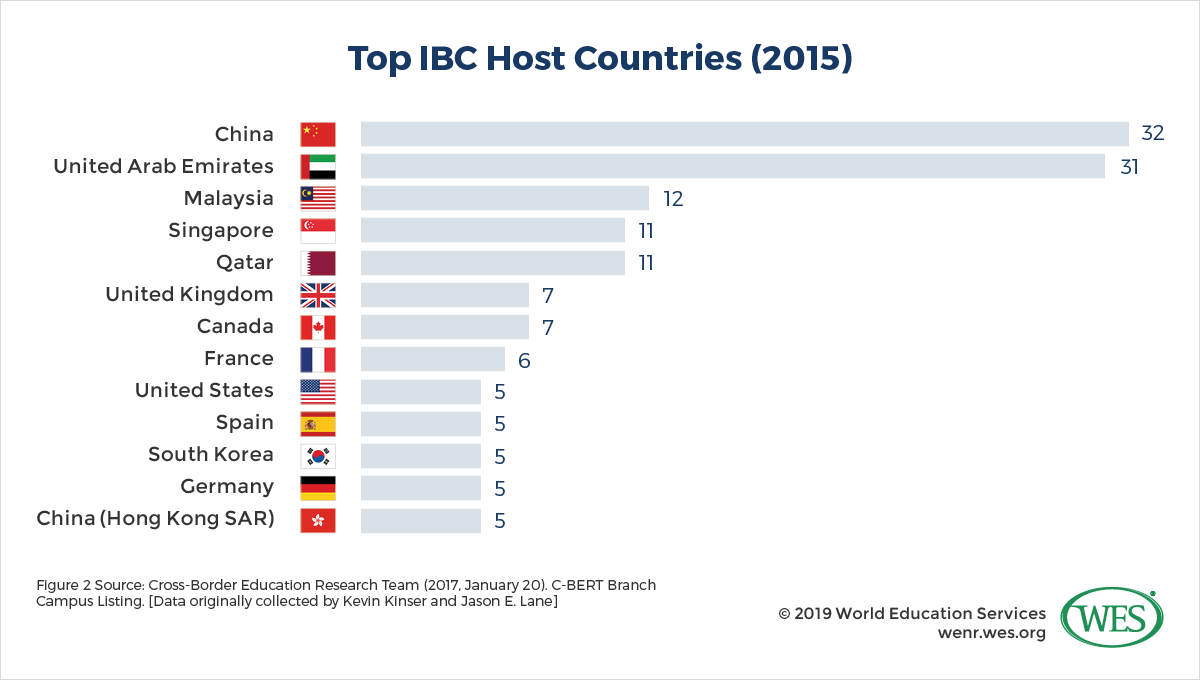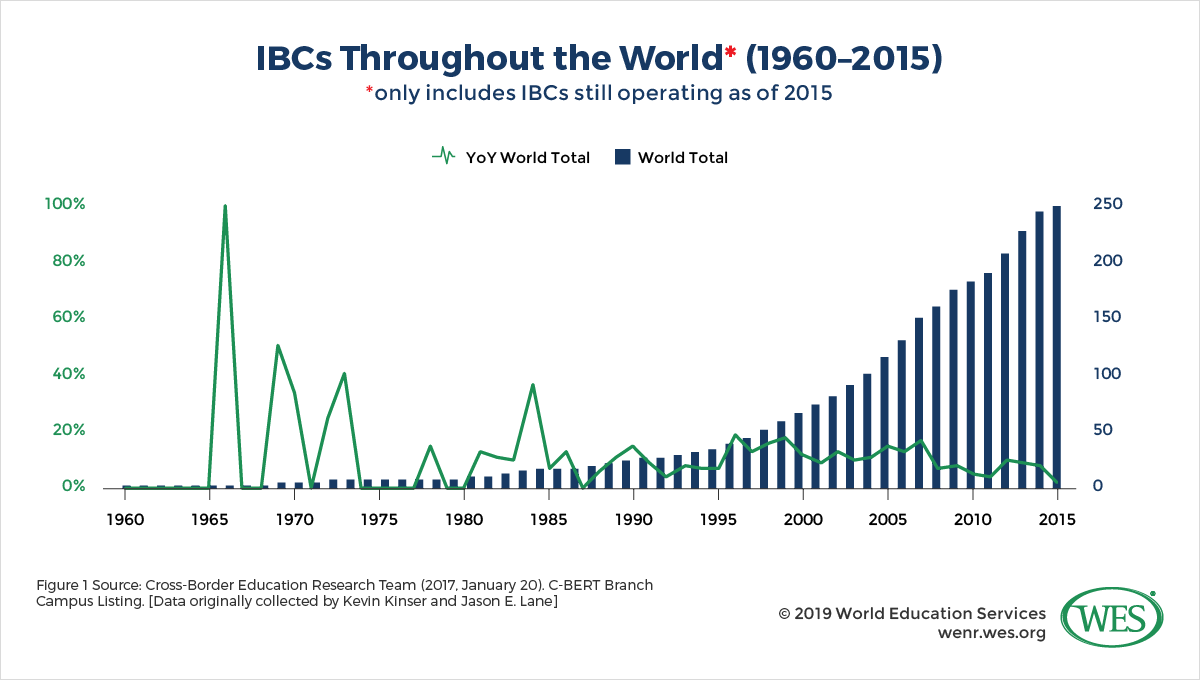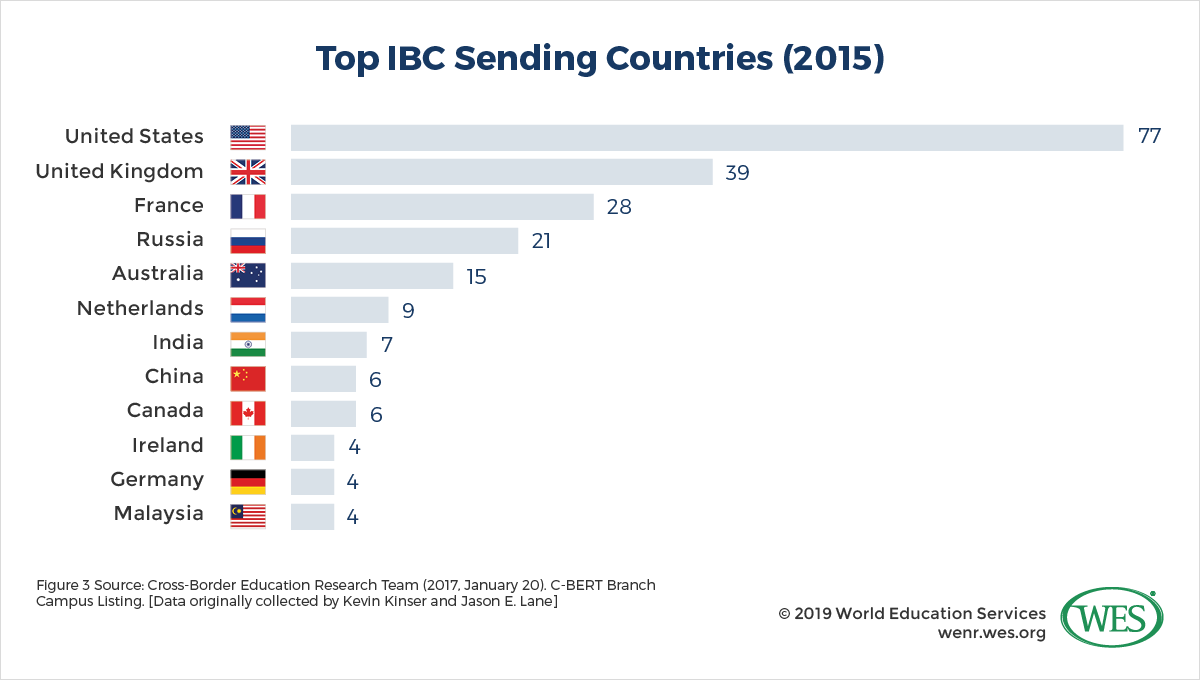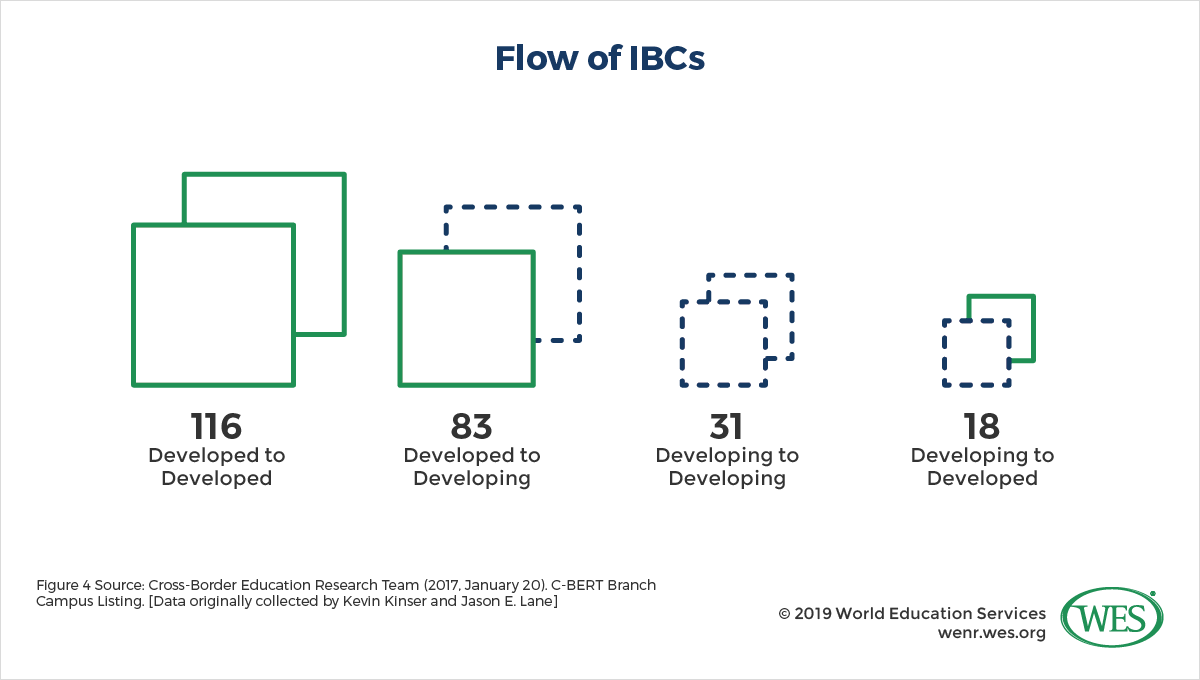Chris Mackie, Research Associate, WES
International branch campuses (IBCs) are among the most visible and resource intensive examples of transnational education (TNE)—which provides education to students “located in a country [2] different from the one where the awarding institution is based.” In a context of increasing international competition and interconnectedness, IBCs are proliferating throughout the world. Countries and institutions that export IBCs see opportunities for student recruitment, revenue generation, and strategic institutional and research ties. Countries importing IBCs see a potential avenue to quickly boost higher education capacity, meet labor market needs, and prevent the loss of human capital.
However, IBCs are not all the same. They differ in their academic objectives, material resources, and organizational structures. The relationships between individuals and entities responsible for IBCs in both the exporting and importing countries also vary widely. These variations often have a significant influence on IBC regulations and practices. They also determine to a large extent the success or failure of any IBC venture.
To delineate the developmental trajectory of IBCs, this article will offer a detailed exploration of IBC trends and the motivations of home and host countries. Understanding how and why different types of IBCs flourish may shed light on their future and their role in the broader TNE context.
Defining IBCs
The definition of an IBC is a matter of some dispute [3]—a reflection of the variety of forms these offshore campuses have taken throughout the world. However, recent research on IBCs has largely been guided by the definition developed by the Cross-Border Education Research Team (C-BERT) [4] and the Observatory on Borderless Higher Education (OBHE) [5], two institutions at the forefront of this research. Their most recent joint report, International Branch Campuses – Trends and Developments 2016 [6], defines an IBC as “an entity that is owned [7], at least in part, by a foreign higher education provider; operated in the name of the foreign education provider; and provides an entire academic program, substantially on site, leading to a degree awarded by the foreign education provider.”
This broad definition serves to distinguish IBCs from other common and closely related TNE models [8], such as study abroad centers, joint degree programs, twinning (or articulation) programs, and franchising arrangements. In contrast to these models, enterprises classified as IBCs under the above definition tend to possess a set of common characteristics. They tend to occupy and teach out of a physical, brick-and-mortar plant in the host country. They are owned—in whole or in part—by an offshore higher education provider. Their operations—such as educational delivery, marketing, and contracting—are conducted in the name of that foreign provider. The curricula and pedagogical approaches used at the IBC are of a quality comparable to that of the home campus. Admission requirements and standards for students are the same as, or comparable to, those for students entering a similar program at the home campus. The faculty includes professors from the home campus or similarly qualified individuals from the host country or a third country. And students are usually citizens of the host country or international students from a third country.
Despite these general characteristics, IBCs are in many ways more accurately characterized by their variety. Because of disagreement over the exact definition of IBCs, the available data on these institutions vary. This article adheres to C-BERT and OBHE’s IBC definition (above), and references the IBC data publicly available on C-BERT’s website [7].1 [9]
Worldwide Trends
IBCs have proliferated rapidly since the early 2000s. According to C-BERT data, there were 67 functioning IBCs2 [10] in 2000. By 2015, the last year for which IBC foundation dates3 [11] are indicated in the online database, that number had more than tripled, to 248 (see Figure 1).
Geographic Dispersion
By 2015, IBCs had spread throughout the world, operating in six continents and 75 countries. The majority (61 percent) are located in Asia.4 [13] China and the United Arab Emirates host by far the most IBCs, with 32 and 31 operating within their borders respectively (see Figure 2). These top two countries import nearly three times as many IBCs as the country with the next highest number, Malaysia, which hosts 12. Qatar and Singapore follow, both hosting 11 IBCs.
 [14]
[14]
The home campuses of IBCs are concentrated in a much smaller number of countries. As of 2015, institutions operating branch campuses abroad were headquartered in only 31 different nations, well under half of the total number of host countries. The geographical distribution of exporting countries also differs from that of importing countries. While IBCs are mainly hosted in Asian countries, the home campuses themselves are situated predominantly in the West.5 [15] Of the 248 IBCs operating in 2015, 211 (approximately 85 percent) were administered from institutions based in Western countries.6 [16] English- speaking countries predominate.
The top two exporting countries—the United States and the United Kingdom—are the source of 77 and 39 IBCs respectively and account for nearly 47 percent of the world’s total IBCs. France, Russia, and Australia round out the top five, exporting 28, 21, and 15 branch campuses respectively (see Figure 3).
Economic and Developmental Indicators
While the flow of branch campuses is to a certain extent multidirectional, with many countries (22 of 83 total receiving/sending countries) both hosting foreign campuses and sending their own abroad, trends in direction and movement can be identified. In particular, branch campuses are far more likely to be established in countries that are less developed economically and educationally than the sending country.
Developed countries7 [18] export the overwhelming majority of IBCs. Around 80 percent (199 of 248) are headquartered in high-income countries, whereas importing countries evince a wider economic range. Developed countries import slightly more than half (54 percent) of the world’s IBCs (134 of 248), including 48 (19 percent) hosted in the oil-rich Arabian Peninsula, while developing countries import the remainder (114 of 248, or 46 percent).
Other economic and development indicators reveal similar patterns. The Human Development Index (HDI) [19]—a composite index measuring a country’s average achievement in life expectancy, education, and standard of living—reveals that just over 75 percent (187 of 248) of IBCs were established in nations that have a lower HDI than the exporting country. On the other hand, considering per capita income alone—a common criterion for evaluating a nation’s economic development—paints a more nuanced picture. IBCs exported from developed to developing countries accounted for 33 percent (83) of branch campuses; those exported from one developed country to another accounted for 47 percent (116); those exported from one developing country to another accounted for 13 percent (31); while the flow from developing countries to developed countries accounted for just 7 percent (18; see Figure 4).
The relative strength of a nation’s higher education system is an important indicator of which countries import and which countries export IBCs. Institutions located in industrialized countries that have advanced higher education systems are far more likely to export branch campuses to nations where the higher education systems are weak. Using Universitas 21’s 2018 ranking of national higher education systems [21] as a measure of relative quality reveals that 87 percent (216 of 248) of IBCs were exported from countries that have a stronger higher education system than the receiving country.
Finally, the use of English as one of the principal languages of instruction in 89 percent (221 of 248) of IBCs worldwide strongly hints at the power dynamics behind these patterns. Institutions at the center of the international knowledge system [22]—a system dominated by industrialized, English-speaking institutions in the West—seek to expand to nations on the periphery, while these nations often aim at integrating their higher education systems more fully into the global education community.
Drivers and Objectives
Underlying the worldwide proliferation of IBCs are a number of interconnected drivers and conditions. These conditions are largely the result of increasing globalization—the growing interconnectedness of the world’s economies, peoples, and, significantly, higher education systems. In the education services sector, globalization has weakened barriers to TNE, driven demand for greater access to higher education, and increased the perceived labor market advantage of Western qualifications.
Advancements in transportation and communications technology—spurred in part by the development and spread of global commodity chains—have made the operation of IBCs logistically possible and commercially viable. Postwar technological developments in the commercial aviation industry laid the foundations that today allow international faculty and staff to fly in and out [23] of host countries to provide in-person teaching—a large part of IBCs’ appeal. More recently, the growing sophistication and reach of information and communications technology have facilitated the rapid and reliable administration and quality assurance of IBCs from the home campus and country, as well as the weightless exporting of learning materials and resources.
These new transportation and communication channels have spread more than just goods and passengers—among its most consequential cargo have been cultural norms and ideas. The spread of policies of economic liberalization—increasingly adopted by countries throughout the world—has weakened barriers to cross-border education. These policies seek to encourage domestic and international trade and capital flows through the introduction of pro-market tax and regulatory regimes. They have driven the growth of IBCs both by boosting supply—by the easing of restrictions to market entry by foreign entities—and by increasing student demand for foreign higher education qualifications. Among other means, the liberalization of international trade has increased demand among export-oriented corporations [24]—encouraged to establish operations in newly liberalizing countries—for internationally recognized and portable qualifications. These corporations are willing to pay a premium for skills considered valuable in the international marketplace—including English-language proficiency and the general competence signified by internationally portable academic qualifications.
A compounding factor is the “massification” of higher education systems [25] around the world. As national economies have developed, the number of students seeking (and able to pay for) higher education has grown. These rapidly rising enrollments have strained the resources of higher education systems in many countries. The supply of public university seats has lagged well behind demand for a variety of reasons, including the stagnation of public funding, implicit or explicit restrictions on the introduction of tuition fees at public universities, and institutional inertia in the face of student demand for more market-oriented programs and languages. These issues have led many countries to weaken restrictions on market entry for private higher education institutions [26], and led governments and public institutions to privatize operations and processes. For the growing numbers of students unable to find seats at domestic universities, overseas study is an increasingly attractive option.
These factors, which both push students away from domestic institutions and pull them toward high status foreign institutions, have contributed to the explosion of international student mobility and TNE programs.
Home Institution Motivations
The development of IBCs can best be understood as a strategic response to the pressures of increasing globalization [27]. Studies on the motivations of home institutions to establish offshore branch campuses have converged on a handful of drivers. Among the most important are the desire to increase revenue, to enhance institutional prestige, and to improve overall academic quality.
Revenue Generation
Policies of economic liberalization are relevant to the regulation not only of international trade, but also of domestic trade. Government support for higher education [28] has been drastically reduced in many countries. The consequent need of HEIs to fill funding gaps has led to increasing competition for private funds and attempts to diversify revenue streams. Among the strategies adopted are the annual raising of student tuition and fees, permanent fundraising campaigns, corporate partnerships, flexible labor contracts, and the development of flashy—and marketable—campus amenities. Institutions are also increasingly marketing their education to international students who can pay full price [29] both in-country and overseas, using a variety of TNE programs to reach international students in their own backyard.
Branch campuses are often intended to be self-sufficient [30] and not subsidized by the home campus. In the case of public universities receiving government funding, spending outside of the state or country may even be legally prohibited [31]. Such restrictions leave tuition fees, investment from a private partner, and host government funding as the main revenue drivers for branch campuses.
IBCs offer a number of pathways to increase revenue for home institutions. They indirectly help funnel additional international students to the home campus. Structured academic programs, which give students the option of completing part of their program at the IBC and part at the home campus—similar to 2+2 or 3+1 articulation programs—serve as an effective recruitment channel for home institutions. The total number of students attracted from IBCs to home campuses is not reported in the aggregate. However, a 2014 Higher Education Funding Council for England (HEFCE) report [32] on transnational pathways to English higher education disclosed that the number of foreign students transferring from a UK TNE program overseas to the home institution increased from 1,960 to 3,200 at high-average tariff institutions in the years 2009/10 and 2012/13. The report attributed this growth to “entrants transferring from overseas branch campuses to the respective HEI in England.”
These schemes can be effective drivers of revenue because home campuses typically charge fees that are significantly higher [33] than those at their respective branch campuses. That said, the tuition fees of IBCs are ordinarily higher than those of their host country competitors. IBCs often market their education as a valuable career investment in order to justify their relatively higher costs. To this end, IBCs often offer programs in fields which prepare students to enter highly remunerative positions after graduation, especially those programs that do not cost much to run.
However, as lucrative as IBCs may appear on the surface, they are not always profitable. There are many documented IBC closures; for example, of the more than 30 U.S. IBCs established in Japan [30] in the 1980s, only one, Temple University, Japan Campus [34], remains today. In light of such closures, IBCs can hardly be viewed as cash cows. The startup capital required to establish a foreign campus far exceeds that required for any other TNE venture, raising the stakes significantly higher. Furthermore, IBC expenses are likely to far exceed those of their host country counterparts. Among other reasons, the foreign faculty hired to staff IBCs typically command higher wages [35] than host country nationals.
The high financial risk and uncertainty involved in establishing IBCs explain their concentration in small but wealthy countries. Countries of greater financial means—such as Qatar, the UAE, and Kuwait—are able to provide generous public support to IBCs—by way of tax breaks, the provision of facilities, or cash transfers—as disclosures of financial arrangements [36] have made clear.
Additional Institutional Motivations
HEIs are motivated to establish branch campuses not only to raise revenue, but also to bolster their reputation and academics.
Reputational Goals and Aspirations
IBCs are an important part of broader institutional goals and aspirations toward internationalization—something many HEIs view as essential to their survival. IBCs are tangible evidence of internationalization efforts and can be used to enhance an institution’s reputation. For example, Georgetown University’s School of Foreign Service opened a branch campus in Qatar in part because of “the principles embodied in its global affairs curriculum [37] and was further inspired by the traditions of global engagement embedded in a Jesuit education.”
Academics
Research: In the context of decreased federal research funding, the opportunity to expand to fast-growing and economically ambitious countries—many of which provide significant research funding—is an attractive prospect for faculty and administrative staff. For example, the government of Qatar [38] funds basic and applied research into areas of national importance, and IBCs are eligible to receive that funding. (In practice, however, IBCs function mainly as teaching institutions [39], and produce relatively little independent research.)
Professional Development: IBCs can develop the capacities of home-campus faculty [40]. By teaching and conducting research in host countries, and by being exposed to intercultural learning opportunities, faculty learn skills they would not learn at home, furthering the internationalization mission of many institutions.
Globalized Learning: IBCs also provide opportunities for domestic students to experience foreign cultures, either through study abroad or intra-institutional exchange programs. These experiences support institutional efforts to prepare students for the demands of an increasingly globalized economy.
Looking Ahead
As measured by the total number of IBCs, the UAE and China8 [41] are among the most prominent host countries. As a consequence of their widely differing positions in global politics and economics, as well as the resulting differences in their strategic objectives, the forms taken by IBCs in these two countries differ in a number of important ways.
In Part Two [42] of this article, we will look at the successful, yet divergent, forms assumed by IBCs in the UAE and China by exploring the conditions that led to the development and structure of their separate branch campuses.
1. [43] In 2016, C-BERT and OBHE published International Branch Campuses – Trends and Developments 2016 [6], the fifth such report and a comprehensive investigation of IBCs throughout the world. The report includes “a full list of known IBCs in operation, along with data on year established, degrees and programs offered, and (where available) student numbers. It also lists all known IBCs currently in development and those recently closed.” Unfortunately, the report was unavailable to the author. As a result, the data used throughout this article are what were publicly available on the C-BERT website [7] as of the date of this article’s publication. Therefore, it may not be either as complete or as up to date as the data in the C-BERT/OBHE’s 2016 report, which is the source of much of the data used throughout the secondary literature on IBCs. While it is hoped that the data used in this article accurately reflect the overall trends of IBCs, for the most up-to-date and accurate data, the reader is advised to consult the 2016 report.
2. [44] Discussion of total numbers of IBCs throughout refers only to IBCs open in 2015, according to the C-BERT data mentioned above. Any IBC which closed before 2015, or opened after 2015, would not be included.
3. [45] C-BERT’s list of IBCs does not include foundation dates for two IBCs functioning in 2015, namely the University of Chicago Booth School of Business, London campus (2005 [46]); and Hult International Business School, London campus (2009 [47]). Foundation dates for both IBCs were found on their institutional websites.
4. [48] Greater Asia, including the Middle East and Gulf Region, Turkey and the Caucasus, and Central, South, East, and Southeast Asia. Does not include Russia or Australia.
5. [49] Europe, North America, Russia, and Australia.
6. [50] Note that any single higher education provider may operate IBCs in more than one country throughout the world (such as Carnegie Mellon University which operates IBCs in Australia, China, Qatar, and Rwanda) or more than one IBC in any single host country (such as the City University of Seattle, which operates four IBCs in Canada alone).
7. [51] Developed countries are defined as high income (>$12,475 GNI per capita); developing countries as low income, lower middle income, and upper middle income (<$12,475 GNI per capita) in calendar year 2015 as reported by the World Bank. [52]
8. [53] This article examines only those IBCs located in mainland China, excluding the special administrative regions of Hong Kong and Macau, both of which regulate TNE independently of the central government.




